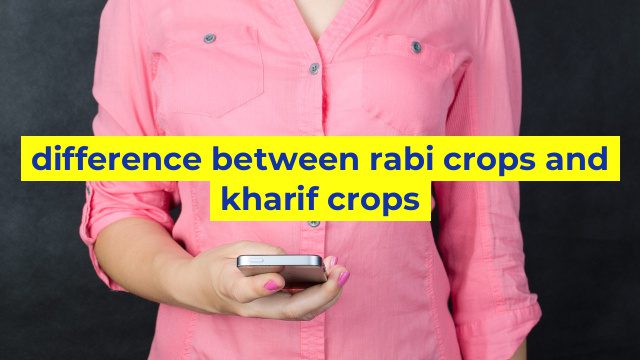Understanding the Difference between Rabi and Kharif Crops
Agriculture plays a crucial role in any country’s economy. India, known for its diverse farming practices, relies heavily on two primary cropping seasons – Rabi and Kharif. Understanding the difference between these two types of crops is crucial for farmers and policymakers to make informed decisions.
Rabi Crops
Rabi crops are sown in winter, typically between October and December, and harvested in spring, between March and May. These include wheat, barley, gram, peas, and mustard, among others. The Rabi season coincides with the winter season when temperatures are mild and soil conditions are ideal for growing these crops.
The key feature of Rabi crops is that they require less water than Kharif crops. Farmers can rely on residual moisture from the rainy season and groundwater to sustain these crops.
Kharif Crops
Kharif crops, on the other hand, are sown in the rainy season between June and September and harvested in the autumn, between October and December. These crops require more water and include paddy, maize, cotton, soybean, and pulses. The Kharif season coincides with the southwest monsoon in India, which brings heavy rainfall across the country.
Farmers need to ensure that sufficient irrigation facilities are available to grow Kharif crops when rain is scarce. In contrast to Rabi crops, Kharif crops require higher investment and more intensive care.
The Importance of Rabi and Kharif Crops
Both Rabi and Kharif crops have their own significance in the Indian economy. Rabi crops account for nearly 50% of the agricultural production in India and provide food security during the winter season. These crops are also helpful in replenishing the soil’s nutrients that may have been lost during the rainy season.
Kharif crops, on the other hand, contribute to nearly 60% of India’s agricultural production. They serve as a primary source of income for millions of farmers across the country and provide raw materials for various industries.
Conclusion
In summary, Rabi and Kharif crops are two distinct agricultural practices that cater to different needs. Understanding the difference between these two crops and their requirements can help farmers make informed decisions about what crops to grow and when. Consequently, it can also help policymakers to design better policies to support farmers across India.
Table difference between rabi crops and kharif crops
Rabi Crops vs Kharif Crops
| Category | Rabi Crops | Kharif Crops |
|---|---|---|
| Type of crop | Crops sown in winter and harvested in spring | Crops sown in summer and harvested in autumn |
| Time of sowing | October to December | June to July |
| Mainly grown in | North India | South India |
| Examples |
Wheat Barley Mustard Peas Gram |
Paddy Maize Groundnut Soybean Cotton |
| Water requirement | Low to moderate | High |
| Fertilizer requirement | High | Low to moderate |
| Land preparation | Requires plowing, harrowing, and leveling | Requires puddling and leveling |


